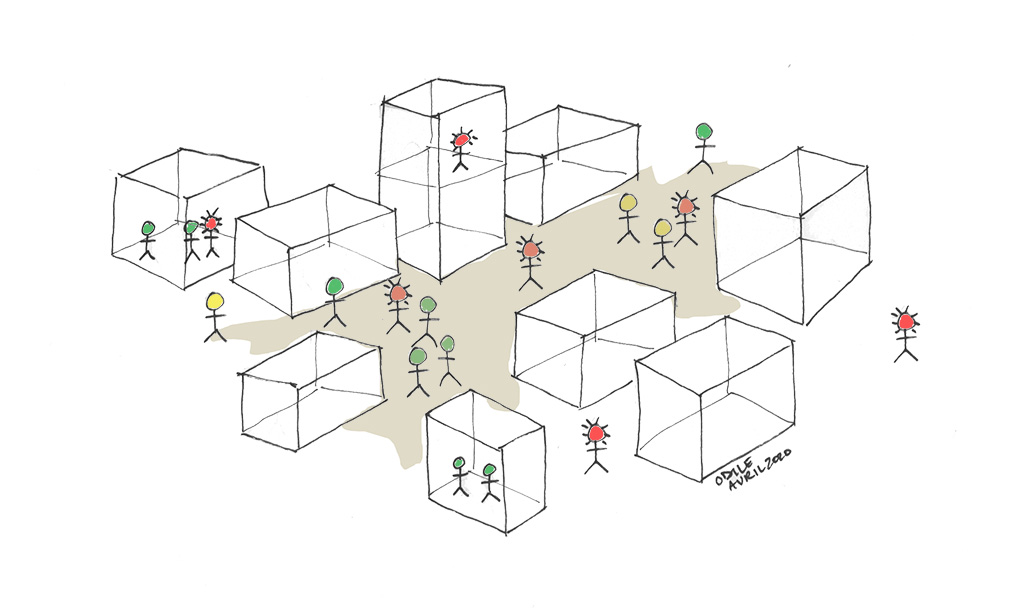Since the beginning of the COVID-19 epidemic, the rules of the lockdown have evolved, becoming increasingly strict (in countries like Italy, Spain or France for instance). Lifting the lockdown could follow the same principle in reverse, more or less rapidly. Each modification of regulations has an influence on the propagation of the virus. Agent-based simulation can model the effect of lockdown rules on the number of infected people. Here we offer a model where you can apply or remove the rules you wish in the sequence of your choice, and then observe the consequences on the epidemic evolution.
A point of caution though before we dive in: this post does not account for people’s motivation to follow the rules imposed (a specific post will deal with this aspect). We also simplify the problem by excluding inter-regional mobility (another post will deal with that aspect), therefore modelling a unique and homogenous geographical zone.
So here is the main idea behind this post: we can model a TOTAL lockdown in a simulation (as was done in question 6) but such a lockdown is unrealistic because in reality:
- Some people still have to go out to work (healthcare workers, police officers, employees of food-related businesses…),
- People still have to go out from time to time (to go food shopping, to walk the dog or exercise…),
- Not everyone will follow the rules, because some of them simply cannot, and some of them – a lower share – don’t subscribe to them.
These three aspects can be regulated by constraining political decisions, such as:
- Setting the list of the shops which can open/have to close down, closing/opening schools…,
- Imposing a curfew, defining the maximum distance people can venture out of their home or the maximum length of time they are allowed out,
- Raising the level of fines, opening shelters.
In terms of modelling, we can reduce the lockdown rules down to three and make them variable:
- Systematic quarantine of people confirmed ill only
- The share of people being locked down (on top of confirmed cases)
- The severity of lockdown (restricted distance from home, frequency of trips per day)
To plan the lifting of confinement measures, the criteria to set up and adjust are the same as these three and they can be used simultaneously or sequentially.
Description of the model
In this model people are either healthy (in beige), either asymptomatic carriers (in brown) when they have been contaminated by being in contact with a carrier. In this last case and after 8 days, they become infected (or symptomatic carriers, in black). 14 days later they are considered recovered (in teal). In the model, each day consists of 4 time steps during which people are allowed to go out (depending on the lockdown severity).

How to act?
In the simulator below, you can set or cancel two main measures to contain the epidemic by locking down a share of population and then lifting the lockdown when you think it is time. You are allowed to take as many actions as you see fit…
The two main measures are the following:
- You can lock down people with confirmed symptoms of the disease. In this case, only symptomatic carriers will be put in quarantine and asymptomatic carriers will remain free to move around and spread the disease.
- You can lock down a share of the population regardless of their carrying status. In this case, you can select the percentage of population to lockdown (0%, 20%, 40%, 60%, 80% or 100%).
NB. If you lock down a percentage of the population (measure 2), infected people will automatically be locked down.
You will also have to choose a lockdown regime, from strict to loose:
- Very strict lockdown: people can go out once every 5 days on average within a radius of 500 meters around their home.
- Strict lockdown: people can go out once every 2.5 days on average within a radius of 1km around their home.
- Loose lockdown: people can go out once within a radius of 2km around their home on average.
NB: Confirmed cases of symptomatic carriers have a different regime of lockdown which is very strict regardless of the regime chosen for the rest of the people: they are allowed out only once every 5 days within a radius of 500 meters around their home.
Over to you…

What we see
Asymptomatic carriers are the most difficult group to manage in this model. We might notice that locking down only symptomatic carriers (in black) will not change much to the epidemic development since asymptomatic carriers (in brown) will keep spreading it.
NB: In reality, asymptomatic carriers are not identifiable, unless they are tested. They are represented in a specific colour here only to highlight their role in spreading the disease.
In practice, in this model, only drastic measures applied as soon as the first confirmed cases are detected allow us to contain the epidemic, or at least to flatten the curve. And still, this is only true if the lockdown is not lifted too soon.
Simulation of (de-)confinement
If the simulator window appears truncated, just zoom out (crtl -).
Reminder: the models developed on this website are for educational purposes only. They are a lot simpler than models built and deployed by other teams working on COVID-19. They are not substitutes for these reference models and cannot be used to make diagnoses or forecasts. Our goal instead is to raise awareness about this epidemic and its drivers.